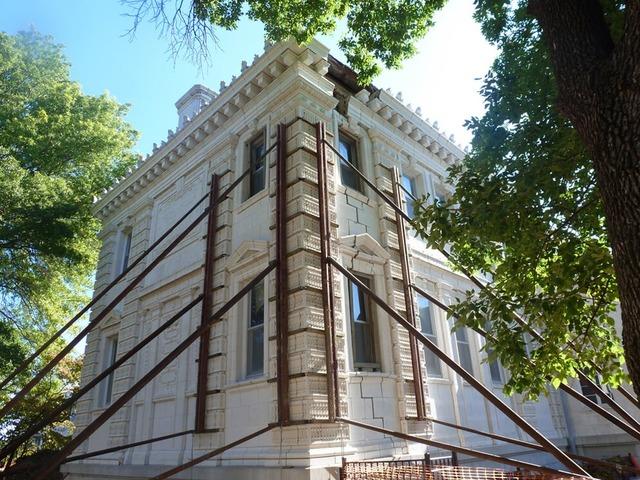Foundation Piering Stabilized the Historic Public Library
Foundation stabilization by Thrasher was an integral part of the repair and restoration of the historic Sedalia Public Library.
Parts of the structure had settled 5″.
The extreme drought that began in the late spring of 2012 had devastating effects across the Midwest, particularly on lawns, crops and foundations. One building hit particularly hard was the Sedalia Public Library. The Sedalia Public Library is a prized building to the local community, and it has been listed on the National Register of Historic Places.
The Sedalia Public Library is located at 311 W. Third St, Sedalia, Missouri. The Sedalia library was first founded in 1895 but was located in the basement of the Pettis County Courthouse. In the Fall of 1899, they were awarded a $50,000 Carnegie Grant to build a new library. This was the first grant to be awarded by Andrew Carnegie in the state of Missouri.
“We were told by the structural engineer that we were in imminent danger of collapse.” – Library Director Pamela Hunter, in an interview with KMBC-TV.
That grant money allowed the residents to build the then-new library. The library is built in the Greek Revival Style of architecture and was constructed of ornate white terra cotta stone with a limestone foundation.
The library was dedicated in 1901 and has been operational ever since, serving the citizens of Sedalia and the greater Pettis County. That is until the concerns over foundation problems arose in 2012.
Foundation problems were first identified in 2012 when a construction worker found "extremely wide" cracks in the foundation in one area of the library. The worker's concern led to a full investigation and, ultimately, the discovery of other severe foundation issues throughout the library.
The library hired a geotechnical engineer to investigate the site subsurface. During the investigation, it was determined that the soil's extreme dryness around the building's perimeter was a significant factor in the ongoing foundation settlement. Further investigation revealed that the underlying bedrock also had large voids beneath them. These large voids were likely the hidden contributor to the over 5" settlement throughout the years. As the corner of the library had settled, it also rotated outwardly and put the foundation and structure at extreme risk of collapse.
Previous attempts by other contractors had been made to correct the foundation settlement issues. Some of the attempted repairs included installing an extensive supplemental concrete footing, along with an elaborate below-grade watering and de-watering system. The supplemental concrete footing and watering system were combined with stabilizing the foundation and controlling below-grade moisture. While well-intentioned, the previous attempts were unsuccessful. The supplemental footing's added weight may have even exacerbated the settling issue, as evidenced by the continued settlement.
The engineers were determined to solve this settlement issue permanently and to protect the historical landmark.
The recommended solution from the engineers was to install a customized micropile system. The plan was to bypass the shallow, unstable soils and fully transfer the foundation load's weight to the competent and stable bedrock. To achieve this result, any piering system would have to be drilled and advanced through the shallow rocks.
Thrasher was selected to perform this stabilization work due to their experience and expertise in micropile installations. Thrasher stabilized the building by first drilling through shallow rock formations and the underlying voids. Thrasher had to drill to depths of upwards of 40 feet to get into competent rock. Forty-nine high-strength steel resistance piers, with an ultimate capacity of 140,000 pounds each, were installed through the pre-drilled holes. The piers were then grouted with high-strength grout to add further lateral and vertical stability to the system. Once the exterior foundations were stabilized in place with the pre-drilled piers, the interior columns, which had not settled, had to be lowered to put the building on a uniform plane. Finally, the unstable soil excavated during the piers' installation was removed and replaced with suitable fill soil.
The result was a permanently stabilized exterior foundation, and interior columns all leveled out to a uniform plane. Sedalia citizens could now rest easy that their historic library was finally placed on solid rock and would not move in the future.
When choosing a contractor to repair your building's foundation, it is not only important to choose a contractor who has the right repair product for the situation, but it is also essential to select the contractor with the right expertise and experience. When choosing to work with Thrasher, you are selecting a contractor who not only knows how to do the work correctly but has over 45 years' experience doing this type of work. So don't leave the work to a beginner. Hire the trusted name in the industry, and call Thrasher.

